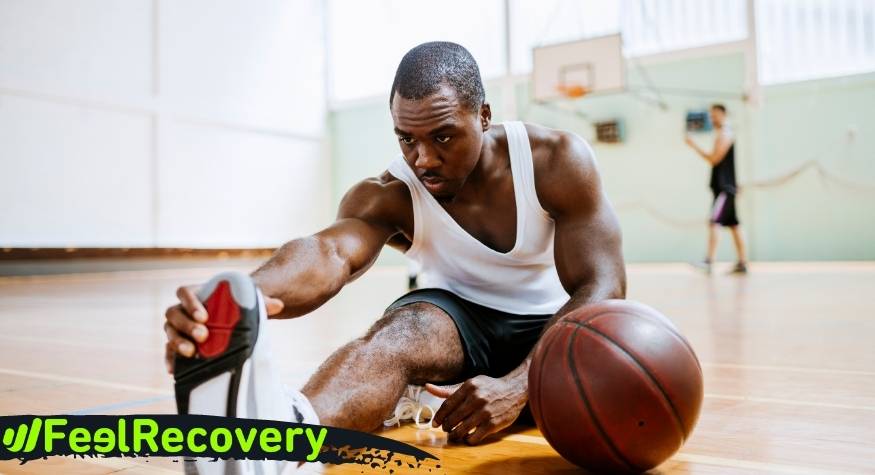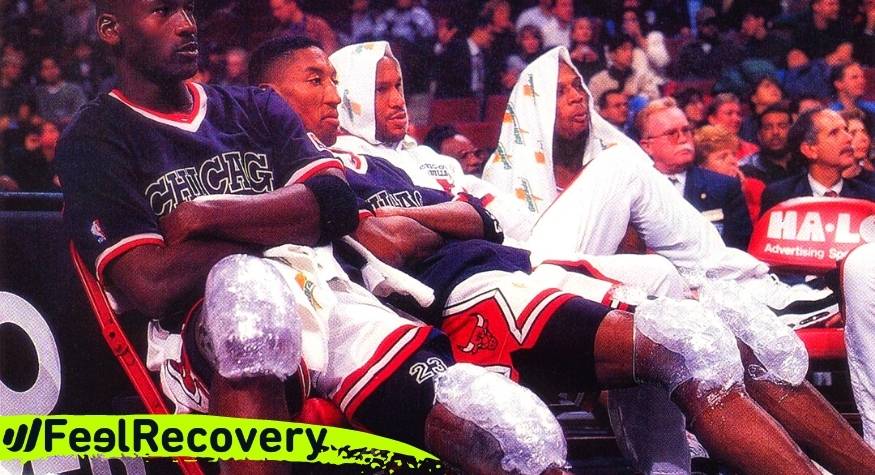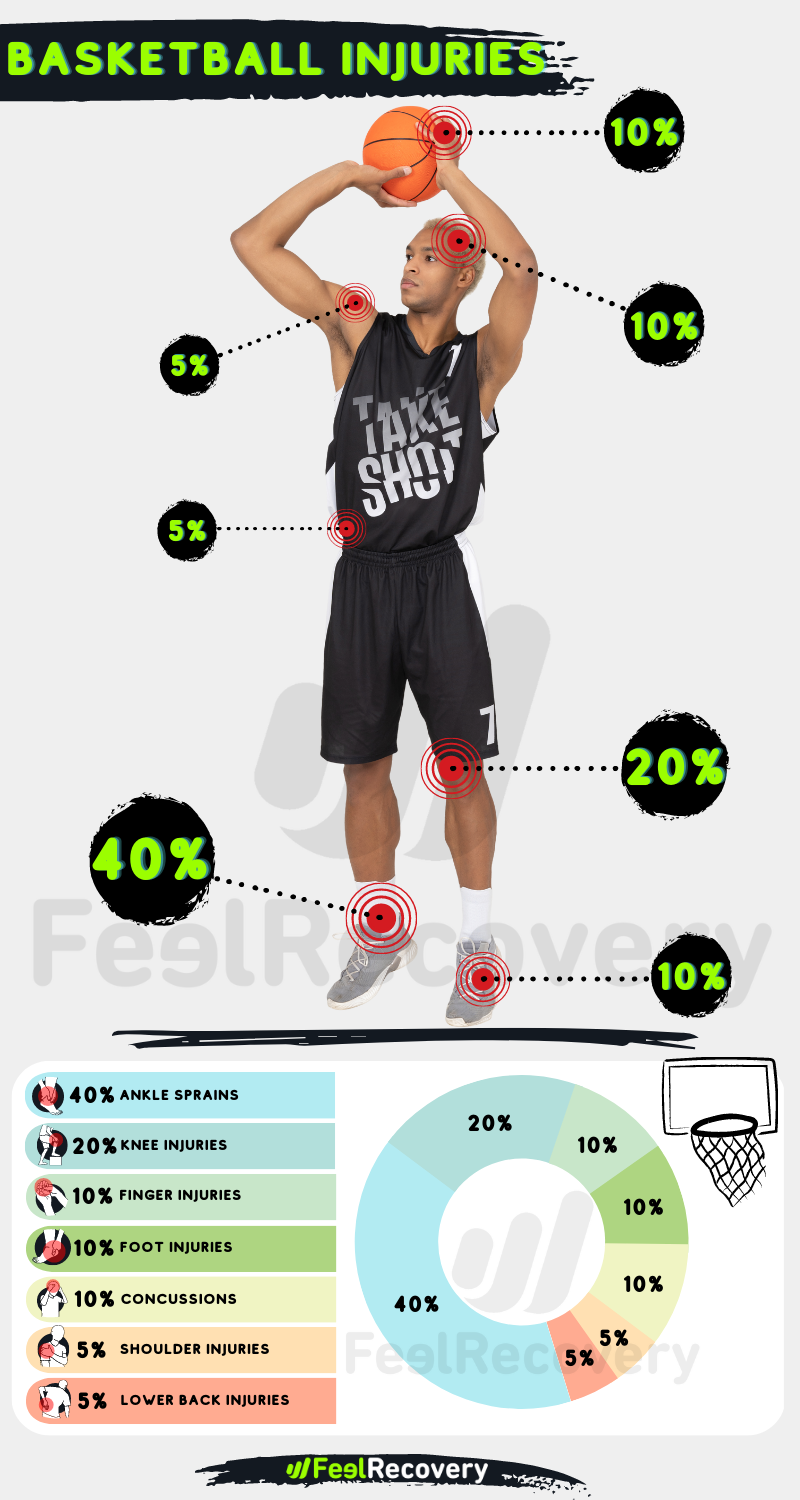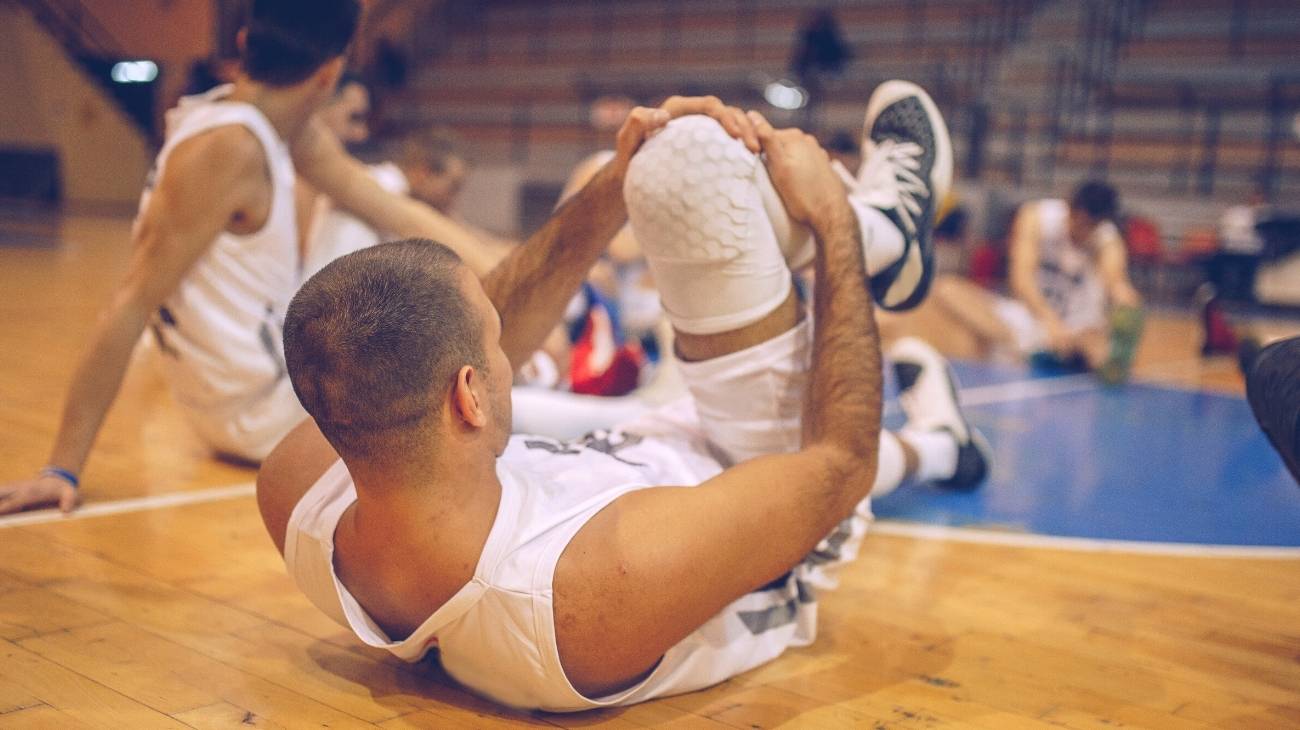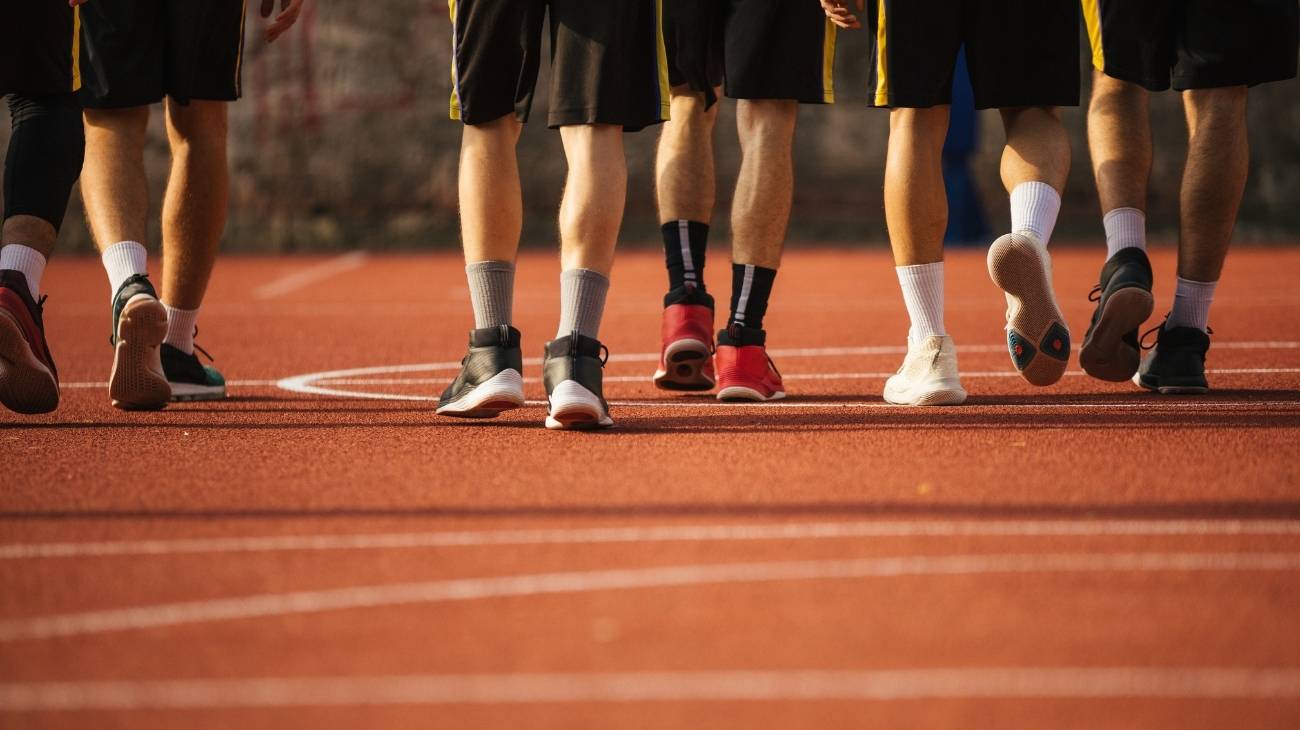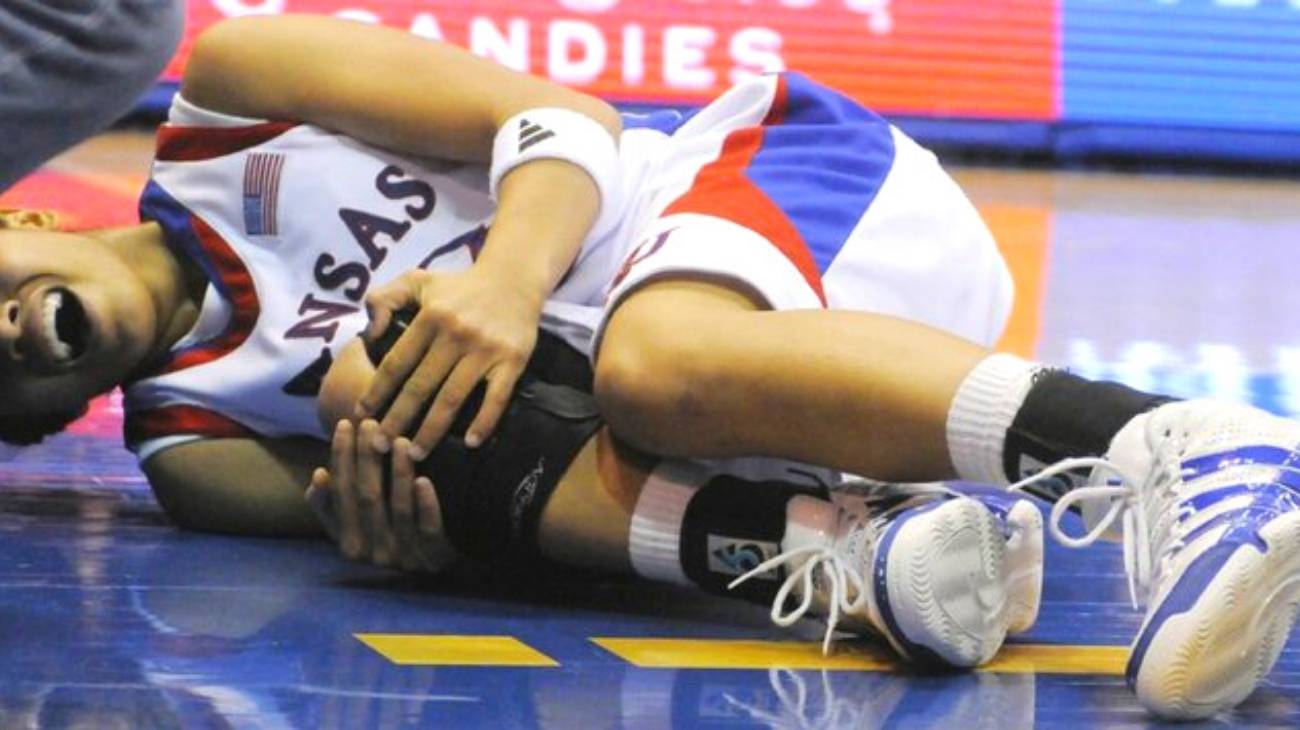- What are the most common types of injuries when playing basketball?
- Best products for basketball injury recovery
- How to prevent injuries when playing basketball?
- How to apply the RICE therapy to treat first aid injuries in basketball?
- When should we see a specialist for the treatment of basketball injuries?
At the professional level, a basketball player can miss an average of seven games in a season due to minor injuries. The intensity with which basketball is played makes the risk similar to that of a football player.
In this article we are going to teach you all about injuries in one of the most demanding sports in the world, from their types and main causes to their treatment and prevention, as well as guide you through the RICE therapy of first aid.
What are the most common types of injuries when playing basketball?
The NBA's official Injury Reporting System provides interesting data on player injuries. What is most striking is that the likelihood of injury to a rookie player is low compared to the likelihood of injury to a player with six seasons or more.
On the neighbourhood courts, where you can see the essence of the game, this factor is likely to be much higher. Here are some of the most common basketball injuries.
Achilles tendon tendonitis
When the Achilles tendon is stretched more than 10% over its capacity, it becomes inflamed and causes severe pain in the player. What happens is that the fibres of the tendon are broken and this causes the tendon to lose strength to perform the movements it needs to perform. Repetitive efforts and the lack of rest for off-court players are usually the factors that have the greatest impact on this ailment.
However, it is also a fairly common problem in adults over the age of 40 who play the sport as amateurs and only play on weekends. Common symptoms are pain and stiffness in lifting the heel off the ground, and a more serious sign that indicates a complete break is that the person cannot stand on tiptoe.
Jumper's knee
Its clinical name is patellar tendinopathy. It is an injury that occurs at the attachment of the tendon to the lower pole of the patella. Immediately there is severe swelling and pain. The main cause is the continuous pulling and contracting force that this tendon undergoes in the constant jumping of players to score, although it can also be caused by an unnatural movement of the knee.
This is a minor injury as it is a simple swelling and with rest and a daily application of the RICE therapy you can be back on the court in a short time. If the swelling is very pronounced, anti-inflammatory medication may be recommended.
Plantar fasciitis
The plantar fascia is important in the take-off and landing phase of a player's jump. It is a tendon structure on the sole of the foot. Rarely does the fascia rupture, however it can become inflamed when the person is overweight or if the centre of gravity is lost and there is a sharp drop on the foot when returning to the ground after a jump.
Another reason why this tissue becomes inflamed is due to wear and tear from constant use, over time it weakens and fasciitis becomes a chronic problem.
Ankle sprain
A sprain occurs when a tendon or ligament in a joint is stretched due to an unnatural movement of the joint, causing the tissues of the joint to partially or completely rupture. There are three degrees of sprains, the first being a simple sprain, the second a more pronounced strain that causes the ligament to become inflamed, and the third degree of intensity being a complete rupture of the ligament.
The symptoms of a sprain are immediate swelling of the affected area, followed by severe pain when trying to use the joint. It is always necessary to have the injury checked by a specialist to identify the extent of the injury, as a break can often start with mild symptoms that can be mistaken for a simple sprain.
Sprained fingers
Although a finger is sprained or fractured by hard blows, in basketball it is common for a finger to be sprained or fractured by a bad pass. The brain and muscle memory sometimes get it wrong and cause you to mis-receive the ball with your hand fully extended. At high speed, it is easy for the fingers to twist and cause pain.
This is an injury similar to a sprain, except that it must be examined in detail to rule out that the damage was not enough to fracture the metatarsal of the affected finger. Dislocation of the toe, which occurs when a joint in the toe slips out of place, can also occur and should be treated in a specialised manner by a competent physician.
Muscle trauma
These are the result of blows, falls or slips that have the players against a hard surface or accidental collisions between the players themselves. In these cases, it is sufficient to apply the PRICE therapy of protection, rest, ice, compression and elevation, which you will see later in this article. Trauma can lead to various muscle injuries, from a simple contusion to a fibrillar rupture, which is a more serious injury that occurs when the muscle tissue breaks down and weakens and limits the functions of the muscle.
Dislocations
In a sport where so much strength and explosiveness is used, it is normal for joints to receive blows that cause bones to move out of position, a condition known as a dislocation. In basketball it is common in both fingers and shoulders and the symptoms are extreme limitation when trying to move the joint, as well as severe pain when doing so.
The joint should be put back in place immediately to prevent it from progressing into a more serious problem. After that the ligaments in the joint often get tendonitis, so you will not be able to return to the court until you have fully recovered from it.
Fractures
A fracture occurs when the bone receives a blunt blow or the inertia of a sudden movement pushes it to the limit, causing it to partially or completely break. When the latter occurs, it is usually called a broken bone, which is the more serious of the two forms.
In basketball we have often seen injuries of this type, being one of the most common due to the intensity of the sport, which especially professionals tend to take to the limit of what is possible. The fact is that it represents one of the most serious injuries, as the recovery time usually takes the player off the court for at least a month. Depending on whether it is partial or complete, the treatment to be followed is decided, ranging from simple bandages and immobilisation accompanied by painkillers and anti-inflammatories, to open surgery.
Best products for basketball injury recovery
Bestseller
-
2 Ankle Compression Sleeve (Black/Gray)
$19.95 -
2 Ankle Compression Sleeve (Green/Navy)
$19.95 -
2 Ankle Compression Sleeve (Pink/Bordeaux)
$19.95 -
2 Calf Compression Sleeve (Black/Gray)
$19.95 -
2 Calf Compression Sleeve (Green/Navy)
$19.95 -
2 Calf Compression Sleeve (Pink/Bordeaux)
$19.95 -
2 Elbow Compression Sleeve (Black/Gray)
$19.95 -
2 Elbow Compression Sleeve (Green/Navy)
$19.95 -
2 Elbow Compression Sleeve (Pink/Bordeaux)
$19.95 -
2 Knee Compression Sleeve (Black/Gray)
$19.95 -
2 Knee Compression Sleeve (Green/Navy)
$19.95 -
2 Knee Compression Sleeve (Pink/Bordeaux)
$19.95 -
2 Patella Knee Strap (Black/Gray)
$14.95 -
2 Patella Knee Strap (Green/Navy)
$14.95 -
2 Patella Knee Strap (Pink/Bordeaux)
$14.95 -
2 Thigh Compression Sleeve (Black/Gray)
$19.95 -
2 Thigh Compression Sleeve (Green/Navy)
$19.95 -
2 Thigh Compression Sleeve (Pink/Bordeaux)
$19.95 -
Acupressure Mat and Pillow (Black/Gray)
$49.95 -
Acupressure Mat and Pillow (Green/Navy)
$49.95 -
Acupressure Mat and Pillow (Pink/Bordeaux)
$49.95 -
Acupressure Pillow (Black/Gray)
$29.46 -
Acupressure Pillow (Green/Navy)
$29.46 -
Acupressure Pillow (Pink/Bordeaux)
$29.46 -
Foot Massage Roller for Plantar Fasciitis (Black)
$19.95 -
Foot Massage Roller for Plantar Fasciitis (Green)
$19.95 -
Foot Massage Roller for Plantar Fasciitis (Pink)
$19.95 -
High Density Foam Roller for Muscle (Black/Gray)
$29.95 -
High Density Foam Roller for Muscle (Green/Navy)
$29.95 -
High Density Foam Roller for Muscle (Pink/Bordeaux)
$29.95 -
Ice Massage Roller Ball (Black)
$39.95 -
Ice Massage Roller Ball (Green)
$39.95 -
Ice Massage Roller Ball (Pink)
$39.95 -
Microwaveable Heating Pad for Pain Relief (Hearts)
$19.95 -
Microwaveable Heating Pad for Pain Relief (Oxford)
$19.95 -
Microwaveable Heating Pad for Pain Relief (Sport)
$19.95 -
Pack 2 In 1 Foam Roller High + Soft Density (Black/Gray)
$29.95 -
Pack 2 In 1 Foam Roller High + Soft Density (Green/Navy)
$29.95 -
Pack 2 In 1 Foam Roller High + Soft Density (Pink/Bordeaux)
$29.95 -
Shoulder Support Brace (Black)
$24.95 -
Shoulder Support Brace (Green)
$24.95 -
Shoulder Support Brace (Pink)
$24.95 -
Soft Density Foam Roller for Recovery (Black)
$29.95 -
Soft Density Foam Roller for Recovery (Green)
$29.95 -
Soft Density Foam Roller for Recovery (Pink)
$29.95 -
Sport Compression Socks (1 Pair) (Black/Gray)
$19.95 -
Sport Compression Socks (1 Pair) (Green/Navy)
$19.95 -
Sport Compression Socks (1 Pair) (Pink/Bordeaux)
$19.95 -
Trigger Point Massage Stick (Black)
$14.95 -
Trigger Point Massage Stick (Green)
$14.95 -
Trigger Point Massage Stick (Pink)
$14.95 -
Wrist Brace (Black/Gray)
$19.95 -
Wrist Brace (Green/Navy)
$19.95 -
Wrist Brace (Pink/Bordeaux)
$19.95
How to prevent injuries when playing basketball?
Before an injury occurs, a player must take into account that nutrition and hydration are as important as good training. However, after an injury there are important therapies and practices to consider for a speedy recovery and return to the court.
Warm-up
A good warm-up session for this sport consists of four parts: activation, joint mobility, stretching and warm-up with the ball. There are times when a combination of exercises can be used, such as "skipping" where while jogging or running you lift your knees as high as possible.
The intensity of the warm-up depends on the coach's recommendations and the suggestions of the sports doctor that each team provides to know how their players' bodies react. On the other hand, warming up with the ball is of utmost importance, as you allow your body to register in its memory how to manoeuvre your hands, torso and legs while dribbling.
Cool down
If you think the warm-up is important, the cool-down is also important. This is what gets your body back to an optimal cardiac and blood state after being agitated. Gentle movements after training have been proven to be more effective than ice therapies in properly cooling down your body.
What are we looking for with cooling down? To get the muscles to loosen up as much as possible. Always find a way to end your workout with a good walk, avoid sitting or lying down suddenly while your body is still agitated. This will make your muscles much more resistant to injury.
The right equipment
Of all the clothing that a basketball player requires, jerseys and shoes are the most important. Jerseys were made of cotton until 10 years ago, when they started to be made of synthetic, breathable material. These help to channel sweat and prevent soggy clothing from becoming a hindrance to the player by making it heavier.
At the same time, the shoes are boot-shaped to give more protection to the ankle, and have the famous air chambers to protect the sole of the foot from falls. The soles have a non-slip design for better acceleration and deceleration. As for the trousers, they must be short, also made of synthetic material. It cannot have a pocket due to NBA guidelines.
Socks or socks are usually white, although the NBA allows the use of colours alluding to the uniform. These are made of cotton for a better grip with the boot. And as you may already know, athletes are not allowed to wear chains, rings, bracelets or any other items that could cause harm to other players.
Nutrition and hydration
In matches, and even in training, it is recommended to take in carbohydrates and electrolytes before, during and after. This will help you gain power and energy. Even though basketball is not a shock sport, the intensity in every game is high and the body burns energy that needs to be supported at all times.
The last meal should be eaten three to four hours before the game, as well as during training. Oatmeal, rice, quinoa, and whole grain pasta are good sources of energy. Include lean protein and fat in your diet to maximise the strength and power of your movements.
After a match, it is best to replenish glycogen stores and promote muscle cell growth and repair. On hydration, water is always an option, but hydration drinks work great during and after exercise or matches. A gallon of water a day is what coaches recommend for a basketball player's pace.
Fitness
A player walks the court about 3 times per minute to either score or defend his hoop, this coupled with the great strength that must be used in each collision and penetration, requires an amateur or professional basketball player to have excellent aerobic endurance.
It is also important that you focus on different exercises that will exercise the muscle memory of the same Bounce ball drills. Play with the ball, do different manoeuvres, practice the different movements that could be executed in a game.
You should also do ball passing exercises, because a mistake affects scores and the strategy of the whole team. As well as these, there are specific exercises for a good shot, for the pivots, stops, starts and a good balance of your body in defence. This is the fitness you should strive for as a professional NBA player.
Recovery therapies
Before an injury, it is important to know your strengths and weaknesses so you know which movements you can repeat with confidence and which ones to avoid. Injury affects neuromuscular capacity, so therapy requires increased coordination, especially intramuscular coordination in strength and agility work. The goals of a recovery go hand in hand with the ailment, this is not based on possibilities, but rather on concrete facts.
Below we discuss the main recovery therapies used in basketball:
- Sports massage: a good massage improves blood flow and improves the lymphatic circulation of the muscle. It is important to clarify that not all injuries should be massaged, that is for the sports doctor on duty to decide. What you should always do is to receive a massage at the end of an intense practice to recover from muscle fatigue and begin to relax.
- Hot and cold therapy: depending on what we want to address an injury, a specialist may opt for heat or cold. Heat combats muscle stiffness, which is why before a match we see players wearing heat packs if they detect any weakness in joints, for example. Heat can also be applied with a warm bath, an electric blanket and hot compresses. Cold is used to reduce inflammation, relieve muscle spasms and reduce pain. Care should always be taken, as neither cold nor heat should be applied for more than 20 to 30 minutes. There should always be a break.
- Use of compression garments: decades ago, they began to be used as a postoperative treatment, but today they are used to improve body performance, among other benefits. With them we look for the regeneration of muscle tissue and the activation of blood circulation. It began to be used in athletics and gymnastics. Now, it is common to see these compression garments in basketball, from jerseys, knee braces, thigh braces to arm covers and calf braces. It reduces muscle fatigue during exercise, lowers muscle vibration during running and in turn the risk of injury.
- Use of acupressure therapy: when a therapist focuses on the right points, he or she is able to drain the accumulated energy in one place. This accumulated energy generates aches and pains in athletes and translates into muscle tension, so it is important that the whole body is free of it. The points and their junctions constitute a network that runs through the whole body and by addressing them, disorders are accommodated and diseases are attacked in patients. Acupressure is similar to acupuncture, the only difference being that fingers and palms are used in acupressure and needles in acupuncture.
- Use of thermotherapy and cryotherapy: Only sports physicians know which type of application is ideal for your body, depending on your ailment. Thermotherapy is the use of heat and cryotherapy is the application of cold to the body, simple as that. Both agree in that they relieve acute pain within 48 to 72 hours, when the injury is severe. However cold is usually used as it reduces the inflammation of the affected part.
How to apply the RICE therapy to treat first aid injuries in basketball?
PRICE is an acronym meaning protection, rest, ice, compression and elevation. PRICE is the update of the initial RICE therapy. It is a procedure that treats a basketball player in the first moments after an injury, however, it extends for 48 or 72 hours depending on the injury:
- Protection: This phase was the last to be added, but the first to be applied. The affected joint is protected with pads or a bandage, without applying pressure for the time being.
- Rest: In the first few moments, the damaged area is given a chance to recover. There should be no immediate attempts to get up if the injury is to the lower limbs.
- Ice: Cold is applied rather than heat because we are trying to reduce the inflammation and reduce the intensity of the pain, which is expected to be temporary. When the pain remains, the best thing to do is to have an X-ray to see what the difficulty is.
- Compression: This step consists of using a bandage to put more pressure on the injury, but it should not be excessive as there are bound to be complications.
- Elevation: If the injury is in the lower extremities, the player should be lying down and the leg should be raised to the level of the heart. When the injury is in the upper extremities, it is possible to be seated with the arm above shoulder level.
When should we see a specialist for the treatment of basketball injuries?
Some injuries are minor, but it is time to discuss with which injuries there should be immediate medical or surgical assistance:
- Sprains: there is a high chance that you will require immobilisation of the leg or arm. In sprains there is a tear in the ligaments that provide stability. A tear causes severe pain and can be partial or total.
- Total dislocation: the bone moves out of its typical place when the player falls to the ground. It is the only recorded cause of dislocation in the shoulder or wrist. Finger dislocations are caused by the ball hitting the outstretched hand at high speed.
- Fractures: can occur in the wrists and ankle, most commonly. In basketball they only occur in spectacular falls of players to the ground.
References
- Harmer, P. A. (2005). Basketball injuries. Epidemiology of pediatric sports injuries: Team sports, 49, 31-61. https://www.karger.com/Article/Abstract/85341
- Newman, J. S., & Newberg, A. H. (2010). Basketball injuries. Radiologic Clinics, 48(6), 1095-1111. https://www.radiologic.theclinics.com/article/S0033-8389(10)00121-1/fulltext
- Trojian, T. H., Cracco, A., Hall, M., Mascaro, M., Aerni, G., & Ragle, R. (2013). Basketball injuries: caring for a basketball team. Current sports medicine reports, 12(5), 321-328. https://journals.lww.com/acsm-csmr/Fulltext/2013/09000/Basketball_Injuries___Caring_for_a_Basketball.13.aspx
- Borowski, L. A., Yard, E. E., Fields, S. K., & Comstock, R. D. (2008). The epidemiology of US high school basketball injuries, 2005–2007. The American journal of sports medicine, 36(12), 2328-2335. https://journals.sagepub.com/doi/abs/10.1177/0363546508322893
- Zelisko, J. A., Noble, H. B., & Porter, M. (1982). A comparison of men's and women's professional basketball injuries. The American journal of sports medicine, 10(5), 297-299. https://journals.sagepub.com/doi/abs/10.1177/036354658201000507
- Dick, R., Hertel, J., Agel, J., Grossman, J., & Marshall, S. W. (2007). Descriptive epidemiology of collegiate men's basketball injuries: National Collegiate Athletic Association Injury Surveillance System, 1988–1989 through 2003–2004. Journal of athletic training, 42(2), 194. https://www.ncbi.nlm.nih.gov/pmc/articles/PMC1941286/
- Bolotin, A., & Bakayev, V. (2016). Efficacy of using isometric exercises to prevent basketball injuries. Journal of Physical Education and Sport, 16(4), 1177. http://efsupit.ro/images/stories/nr4.2016/art188.pdf
- Padua, E., D’Amico, A. G., Alashram, A., Campoli, F., Romagnoli, C., Lombardo, M., ... & Annino, G. (2019). Effectiveness of warm-up routine on the ankle injuries prevention in young female basketball players: a randomized controlled trial. Medicina, 55(10), 690. https://www.mdpi.com/1648-9144/55/10/690
- Sonzogni Jr, J. J., & Gross, M. L. (1993). Assessment and treatment of basketball injuries. Clinics in sports medicine, 12(2), 221-237. https://europepmc.org/article/med/8481963
- McKay, G. D., Goldie, P. A., Payne, W. R., Oakes, B. W., & Watson, L. F. (2001). A prospective study of injuries in basketball: a total profile and comparison by gender and standard of competition. Journal of Science and Medicine in Sport, 4(2), 196-211. https://www.sciencedirect.com/science/article/abs/pii/S144024400180030X
























































































